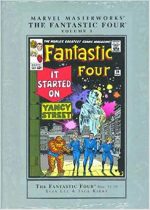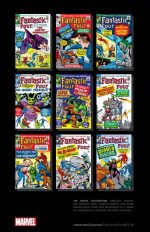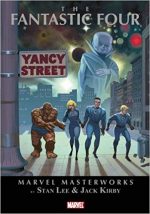


By Stan Lee, Jack Kirby & various (Marvel)
ISBN: 978-0-7851-1182-5 (HB)Â Â Â Â Â Â Â Â Â Â Â Â Â Â Â Â Â Â Â 978-0-7851-4296-6 (TPB)
Fantastic Four #1 is the third most important American comicbook in the industry’s astounding history. Just ahead of it are The Brave and the Bold #28, which brought superhero teams back via the creation of the Justice League of America. At the top is Showcase #4, which introduced the Flash and therefore the Silver Age. Feel free to disagree…
After a troubled period at DC Comics – National Periodicals as it then was – and a creatively productive but disheartening time on the poisoned chalice of the Sky Masters newspaper strip (see Complete Sky Masters of the Space Force) Jack Kirby settled into his job at the small outfit that used to be the publishing powerhouse Timely/Atlas.
He churned out mystery, monster, romance and western material in a market he suspected to be ultimately doomed, but as always, did the best job possible. That quirky genre fare is now considered some of the best of its kind ever seen.
However, his fertile imagination couldn’t be suppressed for long and when the JLA caught the readerships attention it gave him and writer/editor Stan Lee an opportunity to change the industry forever.
Depending upon who you believe, a golfing afternoon led publisher/owner Martin Goodman ordering his nephew Stan to try a series about a group of super-characters like the one DC was doing. The resulting team quickly took fans by storm. It wasn’t the powers: they’d all been seen since the beginning of the medium. It wasn’t the costumes: they didn’t have any until the third issue.
It was Kirby’s compelling art and the fact that these characters weren’t anodyne cardboard cut-outs. In a real and a recognizable location – New York City – imperfect, raw-nerved, touchy people banded together out of tragedy, disaster and necessity to face the incredible.
In many ways, The Challengers of the Unknown (Kirby’s prototype partners-in-peril at National/DC) laid all the groundwork for the wonders to come, but the staid, almost hide-bound editorial strictures of National would never have allowed the undiluted energy of the concept to run all-but-unregulated.
Fantastic Four #1 (bi-monthly and cover-dated November 1961, by Lee, Kirby, George Klein & Christopher Rule) is crude: rough, passionate and uncontrolled excitement. Thrill-hungry kids pounced on it.
As seen in that ground-breaking premier issue, maverick scientist Reed Richards, his fiancée Sue Storm, their close friend Ben Grimm and Sue’s teenaged brother survived an ill-starred private space-shot after Cosmic rays penetrated their ship’s inadequate shielding and mutated them all.
Richards’ body became elastic, Sue gained the power to turn invisible, Johnny Storm could turn into living flame and poor, tragic Ben devolved into a shambling, rocky freak. Despite these terrifying transformations, before long the quartet had become the darlings of the modern age: celebrity stalwarts alternately saving the world and publicly squabbling shamefully…
This full-colour hardcover or paperback compendium (also available in various digital formats) collects Fantastic Four #21-30 – spanning December 1963 to September 1964.
Sgt. Fury and his Howling Commandos was another solid Marvel hit. Eventually its brusque and brutal star would metamorphose into the company’s answer to James Bond. Here, however, he’s a simple CIA agent seeking the team’s aid against a sinister demagogue called ‘The Hate-Monger’ in a cracking yarn with a strong message, inked by comics veteran George Roussos, under the protective nom-de-plume George Bell.
By this juncture the FF were firmly established and creators Lee & Kirby were well on the way to toppling DC/National Comics from their decades-held top spot through an engaging blend of brash, folksy and consciously contemporaneous sagas, mixing high concept, broad comedy, trenchant melodrama and breathtaking action.
Unseen since the premiere issue, #22 finally featured ‘The Return of the Mole Man!’; another full-on monster-mashing fight-fest, chiefly notable for the debut of the Invisible Girl’s newly developed powers of projecting force fields and “invisible energyâ€.
After an incredibly long period these would eventually make her one of the mightiest characters in the company’s pantheon…
Fantastic Four #23 heralded ‘The Master Plan of Doctor Doom!’, and introduced his frankly mediocre minions the Terrible Trio of Bull Brogin, Handsome Harry and Yogi Dakor. Even after thy were boosted by Doom’s science the goons were sub-par but the uncanny menace of “the Solar Wave†was enough to raise the hackles on my 5-year-old neck… and still does…
(Do I need to qualify that with: all of me was five but only my precious neck had developed hackles worth boasting of back then?)
Issue #24’s ‘The Infant Terrible!’ was a sterling yarn of inadvertent extra-galactic menace and misplaced innocence, as New York is besieged by a lost and wilful alien child with the power to reshape reality.
It’s followed by a two-part epic that truly defined the inherent difference between Lee & Kirby’s work and everybody else’s at that time.
Fantastic Four #25 and 26 featured a cataclysmic clash that had young heads spinning in 1964 and led directly to the Emerald Behemoth finally regaining a strip of his own. In ‘The Hulk Vs The Thing’ and concluding clash ‘The Avengers Take Over!’, a fast-paced, all-out Battle Royale resulted when the gargantuan green man-monster came to New York in search of side-kick Rick Jones, and only an injury-wracked FF stood in the way of his destructive rampage.
Highlighting a definitive moment in the character development of The Thing, the action is ramped up when a rather stiff-necked and officious, newly-constituted Avengers team horn in, claiming jurisdictional rights on “Bob†Banner (this tale is plagued with pesky continuity errors which would haunt Stan Lee for decades) and his Jaded alter ego.
Notwithstanding the bloopers, this is one of Marvel’s key moments and still a visceral, vital read.
The creators had hit on a winning formula by including their other stars in guest-shots – especially as readers could never anticipate if they would fight with or beside the home team.
‘The Search for Sub-Mariner!’ again sees the undersea anti-hero in amorous mood, and when he abducts Sue the boys called in Doctor Strange, Master of the Mystic Arts to aid them… Issue #28 is a superb team-up tale too, most notable (for me and many other older fans) for the man who replaced George Roussos.
‘We Have to Fight the X-Men!’ has the disparate teams clashing due to the machinations of Puppet Master and the Mad Thinker, but the inclusion of Chic Stone – Kirby’s most simpatico and expressive inker – elevated the art to indescribable levels of slick, seductive quality.
‘It Started on Yancy Street!’ (FF#29) begins in a low-key manner with plenty of silly basic comedy on show as the team investigate a crime wave in the slum where Ben Grimm grew up. After dodging cabbages and garbage, things get serious with the reappearance of the Red Ghost and his Super-Apes before the action quickly goes full-on Cosmic…
Abducted into space, the heroes enjoy blockbusting battle on the Moon and another dauntingly close encounter with the omnipotent Watcher…
The following issue introduced evil alchemist ‘The Dreaded Diablo!’ who almost breaks up the team while casually conquering the world from his spooky Transylvanian castle. His divide and conquer strategy involved almost curing The Thing of his monstrous deformity, but alchemy, unlike friendship, proves to be fleeting and untrustworthy…
This is a truly magnificent book to read, highlighting the tales that built a comics empire. It’s actually so well-crafted that it could easily work as anybody’s introduction to the most famous family in comicbooks.
The verve, imagination and sheer enthusiasm shines through and the wonder is there for you to share. If you’ve never thrilled to these spectacular sagas then this book of marvels is your best and most economical key to another world and time.
© 1963, 1964, 2017 Marvel Characters, Inc. All rights reserved.
